Text
A Hometown of Memories, a Dracut, Massachusetts Review
Dracut, Massachusetts is a tucked away town in Massachusetts, where everyone knows everyone. I fondly remember driving home from school with my friends, and we would count how many farms we passed while on the way to my house. As a life-long resident of Dracut, I can write with confidence that I am able to give a sufficient review of my hometown. A small town, with just over 30,000 residents, Dracut is north of Lowell, MA, and south of Nashua, NH, and is a part of Middlesex County. Dracut is not known for its nightlife or over-the-top entertainment features, but it provides residents and visitors with a relaxing and quiet place to spend time in. Dracut is a town that is developing in infrastructure and attractions, which likely will increase the desire of young families to move here. A wholesome place to raise a family is often why one settles in Dracut, and this contributes to the growing number of children in the community. There is also an increased elderly population in Dracut, made up of retired adults and older farmers, for which Dracut is also well-known. As the population has increased, the farmland has in turn decreased, though Dracut is still a “Right-to-Farm” community. This essentially means that farming practices are welcomed in the community, therefore leading to increased farmland, and it is not uncommon to see a tractor or other farm vehicle driving in front of your car on one of Dracut’s roads.
Dracut is home to some of the more well-known farms in Middlesex County. The most popular is undoubtedly Shaw Farm, a local dairy farm that has been in the community for over 100 years. This longevity is a common theme in Dracut, as many farms have been passed from generation to generation in a family. The Shaws own a dairy farm, a yearly general store and ice cream stand, and a yearly breakfast and lunch restaurant. The dairy farm, general store, and ice cream stand are located in the southern part of town, right before Dracut High School, while the restaurant is located on the northern side of town, closer to my home. The dairy farm and ice cream stand have expanded over the years, yet still offer a traditional, storybook image of a dairy farm. On summer days, the cows graze the fields that border the road, and when it is warm outside, you can smell the manure long before you can see the farm. Shaw Farm is renowned for their chocolate milk, which is thick and creamy, with an almost milkshake-like consistency. This milk and other products are delivered to surrounding farms, and can be considered Dracut’s most famous product.
Another local attraction is Ogonowski Farm, owned by Jim Ogonowski. The Ogonowski name is another family that have been Dracut residents for generations. The name achieved notable national recognition with the death of John Ogonowski, Dracut resident and pilot of American Airlines Flight 11 that was hijacked and crashed into the World Trade Center on September 11, 2001. Ogonowski Farm and the town of Dracut have a number of monuments honoring John Ogonowski throughout the town, and the name is viewed with honor and respect. Ogonowski Farm is known for its fall sale of chrysanthemums, pumpkins, cornstalks, and hay bales that make festive fall decorations. The shop is located on the central road in Dracut, Broadway Road, allowing for easy accessibility from all sides of town. The storefront in the fall is a beautiful photo opportunity, as the mums bloom in vibrant shades of red, yellow, white, and purple, and the wagons of pumpkins surrounded by hay bales are a delight for children to sort through and select.
In terms of restaurants, Dracut offers a variety of Chinese, Italian, pub-style, and pizza restaurants, with one high-end Italian restaurant and function hall, that is located on Dracut’s golf course and country club. A majority of the restaurants are inexpensive and provide food items that range in quality, with a number of townie favorites having emerged throughout their existence.
One is Brothers Pizza, which was newly renovated in the past year, and provides a great environment for pub food, a bar, and a local gathering spot to watch a game or enjoy a meal with family and friends. I personally remember attending their $5 burger nights with my friends on Tuesdays in high school, and eating post-soccer practice meals with my team here, as the staff was always accommodating to children.
Mama’s is an Italian classic. Albeit having a dated design and decor, the restaurant provides great value for the price and size of a dish, as well as the best chicken parmesan in town. My family still frequents this restaurant, and swears by their bread, which I will have to agree, is also the best in town.
Yujo is a popular sushi restaurant, offering hearty and quality rolls, as well as half-price rolls on both Wednesdays and Sundays. I was introduced to this restaurant by my best friend, whose family frequents the establishment so often that they are asked “the usual table?” whenever they arrive.
Family Pizza is a small shop on Lakeview Avenue that is a hotspot for a place to eat after a high school event or after school. In fact, I attended grade school and played both soccer and basketball with the owner’s son, so they are another well-known name in the community. I, and many other former Dracut students, have fond memories of walking across the street from the Dracut schools to Family to grab a “two-slice-all-set,” which is two slices of hot cheese pizza and a drink for a discounted price.
And finally, the higher end restaurant is Grazie, an Italian-styled restaurant located directly bordering the town’s golf course, Four Oaks, which offers family-style seating, along with higher-class seating near a bar. Grazie may be a newer restaurant in the community, but it brought a welcome change as the community’s infrastructure and image have begun to develop in recent years.
Dracut High School was newly renovated in 2013, updating a school that was both outdated and ill-equipped to serve students. The education system is not known for being fantastic in Dracut, and I personally only attended public schooling in Dracut until high school, but the technological advancements and updates the school system has made cannot be ignored. Dracut is currently constructing new fields in the school plaza, where an elementary, junior high school, and the high school are located. Upon the project’s completion, there will be a new turf football field, soccer field, and track and field area for students and residents to take advantage of.
The Dracut school complex is mainly condensed in one area surrounding the high school in the southern part of town. This plaza offers an elementary school, middle school (grades 5 and 6), junior high school (grades 7 and 8), and high school. Dracut has three operating elementary schools, and I attended the one on the northern side of town, Campbell Elementary School. I have some of my fondest memories attending the K-4th grades here, and still occasionally visit due to the basketball courts behind the school, referred to fondly as “the courts.” Campbell School offers four basketball courts, where summer basketball leagues are held, which I was a yearly participant in. Furthermore, the Campbell has not one, but two, playgrounds, and a baseball field. Growing up, these made for fantastic outdoor recesses, and I know students are still taking advantage of the facilities Campbell has today.
As I explained earlier, everyone in Dracut knows everyone. It’s no surprise if you see your kindergarten teacher in line at Shaw Farm, or see a friend from church walking on the street. Dracut does not have a legitimate “town center,” and I live on the northern side of the town, while more business areas and schools occupy the southern side. My side of Dracut occupies a majority of the farming area that Dracut is known for, albeit not the most famous farm in town in Shaw Farm. As Dracut has become more modern, the community has shown no opposition to the changes, as long as the farmland remains to a large extent. Dracut has built a new health center in the middle of town in the past two years, that borders an assisted living facility that was built not long after. My own grandparents moved into an over 60 community in Dracut in the past year after living in Billerica, Massachusetts for over 40 years, and were welcomed with open arms. Dracut is a town of tradition, but they have also demonstrated a willingness to change and grow, as long as the locals are not asked to remove what they value from the community. A Dracut resident’s home is their sanctuary, a place to relax, yet also remain connected towards what they value in the community.
While not the flashiest of towns to grow up in, Dracut offers an experience that not many in 2020 can say that they are growing up with, a farm-centered and close-knit community. The town is quiet, and most of the residents know each other, but Dracut offers much in terms of comfort, relaxation, and fellowship. Furthermore, Dracut borders bigger towns and cities, making for easy access to events geared towards bigger thrill-seekers. But honestly, who can forget the Shaw Farm chocolate milk? You’ll want to visit Dracut for that alone!
3 notes
·
View notes
Photo
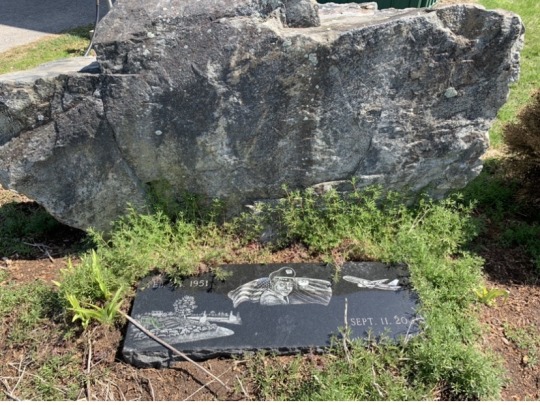
A Memorial to John Ogonowski, former owner of Ogonowski Farm, who was killed in the 9/11 Attacks.
3 notes
·
View notes
Text
Producing for Dracut: Saja Farm’s Community Contribution
The Coronavirus has closed dine-in restaurants, non-essential businesses, and changed daily life for everyone throughout the United States. But one small farm in Dracut, Massachusetts is attempting to do their part in providing food for the community in a safe environment.
Caroline Zuk, owner of 60 acre Saja Farm in Dracut, is a woman who is proud of her family heritage. The Saja family are Polish immigrants who settled in Dracut in the early 20th century to start a new life farming the land. Zuk inherited the family farm from her grandmother in 2010, and has not allowed her grandmother’s values to disappear as ownership changed hands.
“I grew up farming my whole life,” Zuk said. “We worked the dirt, no grocery store, we would grow it. This was the European way, we did and made everything ourselves.”
This mentality remained with Zuk into her adult life, even as she was told by her family to leave the farm and pursue her own interests outside of agriculture. Zuk attended the Wentworth Institute of Technology in the ‘80s and received a degree in Electrical Engineering, but inherited the farm from her grandmother and decided to return to farming as a profession.
The inheritance of Saja Farm came with mixed emotions, as Zuk knew it would be a big project, but felt that she had a right to keep the land in the family name. Zuk is married, and her husband works as a computer analyst while also helping out on the farm when he can. The two of them adopted three children from South Korea, two of which are now in high school, and one of which is in college. Zuk’s children help out on the farm, but Zuk assures them that this is not what they have to do for the entirety of their lives if they do not want to.
“I want farming to be something that I can teach to my children,” Zuk explains. “But I always tell them, don’t feel like farming has to be the number one thing on your list.”
However, Zuk’s children’s help has been greatly needed as the Coronavirus has swept through the United States in the past few months. The state-wide restrictions imposed on business do not impact the farming business, as they are considered essential businesses. Instead, farmers throughout the state are worried about the willingness of customers to shop at farms. Yet, Zuk saw a need in the community, a need she believed could be satisfied with the produce her farm grows, including corn, tomatoes, peppers, other vegetables, and eggs.
In mid-February, Zuk was in a local Market Basket, and was walking through the produce section on her way to the register. What Zuk saw surprised her, as there was produce that she claimed “was damaged and looked like it had been handled multiple times.” Zuk began to have conversations with friends in the farming industry about “how we can do better than the selection in Market Basket right now,” along with the potential impact the Coronavirus may have on business. Then, based on what she called “my intuition,” she correctly predicted when the virus would be impactful and began to prepare.
Zuk made preparations for Saja Farm to outsource produce from farms in warmer states with the quality she trusted from throughout the country. Outsourcing began towards the end of February, when there was still snow on the ground and no chance of Zuk being able to grow her own produce. As shipments of organic produce from states as far away as Florida began coming in, Saja Farm was able to provide farm-fresh produce earlier than they ever had before. As the virus progressed, outsourcing proved to be beneficial to both the farm, and more importantly, members of the Dracut community.
We’ve never outsourced like this before,” says Zuk. “I want to make food available to people that can’t go into the grocery store.”
Zuk has a weakened immune system herself, and understands the severity of the virus for those in situations like herself. In outsourcing produce from other farms, Zuk was able to get a headstart on the virus, and provide another outlet for people to obtain fresh, high-quality food.
Saja Farm has remained open throughout the pandemic, with Zuk working behind the register herself for hours a week. Due to the virus’ severity, and Zuk’s concern for her own health and the health of her customers, extra precautions have been made in order to remain operational.
Aside from the Saja Farm stand being an open area, where customers can shop from six feet apart, customers and employees wear masks and gloves, as they handle food. Furthermore, Saja Farm has a large sign at the entrance that reads “if diagnosed with COVID-19 or under in-house quarantine you cannot come into the store.” Zuk explains that she understands the seriousness of the whole situation, but wants to be able to provide people with an opportunity to purchase fresh produce in an environment that they can feel comfortable in.
“Of course I’m still scared of [the Coronavirus],” says Zuk. “If one person in my family or someone who shops here gets the virus, we can’t sell anymore. But we hope that our customers will see that the extra precautions are not only a courtesy to us, but also to others.”
Zuk has begun considering the possibility of a “grab-bag” program, where community members who have been especially impacted by the Coronavirus can come during select hours and pick out a bag of produce, all for free. Zuk understands that there are people in need who may have lost their jobs, and rather than throw out the “ugly” food that does not look as appealing yet still tastes just as good, it can be given out to those in need. She also plans to include a few basic recipes that the fruits and vegetables can contribute to, all in an effort to help her community during these trying times.
In my time speaking with Zuk, one thing was certain: she cares about the Dracut community. As a life-long Dracut resident, Zuk understands that what makes Dracut special is the community’s willingness to band together during times of hardship. Rather than open up Saja Farm in the summer when restrictions due to Coronavirus have begun to lessen, Zuk opened up her farmstand to the community that has allowed her to operate all these years. Farming and the Dracut community is a mutualistic relationship, and that is something all Dracut residents take pride in.
This pride is what keeps customers coming back to Dracut farms, and what causes Zuk to be so invested in the farm she has owned for the past ten years. Even in times of crisis, Zuk remains caring and open to her community, and nothing is more demonstrative of this belief than Zuk’s explanation for growing her produce.
“Farming is like raising children,” says Zuk. “Except I have 30,000 children that I am growing.”
3 notes
·
View notes
Text
A Life of Farming and Change with Jim Ogonowski
Dracut, Massachusetts is a rural farmtown, made up of acres of farmland and farm stores. One of these farms is Ogonowski Farm, a hay and chrysanthemum farm that is owned by lifelong Dracut resident, Jim Ogonowski. Ogonowski Farm has occupied the Dracut area for over 100 years, and has been in the Ognowski family for generations.
Ogonowski Farm, now totaling roughly 260 acres, operates from two separate locations in Dracut, one on Marsh Hill Road, where a majority of the land is owned, and one on Bridge Street, where a fall storefront sells chrysanthemums, show bales, corn stalks, pumpkins, and apples. The Marsh Hill location has a large hay barn, workshop, a peach orchard and chrysanthemum field, and numerous hay fields and tractors. This location serves as a loading point for hay deliveries, hay cultivation, and other projects that may arise. The fall storefront location is where Ogonowski was raised, and his mother and sister still live in the house that occupies the space.
Ogonowski is a retired Air Force Colonel, having served 28 years, 22 of which were spent in the Air Force National Guard. He became the farm’s main owner after the loss of his brother John, who was the pilot of American Airlines Flight 11, and tragically died in the attacks on September 11, 2001. Jim Ogonowski grew up in Dracut watching his family farm for their livelihood, and has witnessed firsthand how the Dracut community has developed since Ogonowski was a boy.
Ogonowski, now 64 years old, is happy to live a simple life, yet he has experienced much throughout his years. After his brother’s death, he ran an unsuccessful campaign for a seat in the U.S. Congress after retiring from the Air Force. Ogonowski had no prior political experience, and ultimately lost by a close margin in the general election to Niki Tsongas, after advancing in the Republican primaries. While he no longer relishes the opportunity to talk about his political career, this is but one example of the vitality Ogonowski has for life. He is quick to share stories about drying hay by pitchfork as a child, and reminds his employees how lucky they are to have machines that can now do it for you. Ogonowski is still a daily participant in farm labor, and is always working on a project. He is married to his wife Kathy, owner of Rising Star Equestrian Center, and has two children and seven grandchildren.
Throughout this interview, Ogonowski and I discussed not only his farm, but the entirety of Dracut as a farming community. We talk about how things have changed for him throughout his farming career, and how he has witnessed firsthand the development of Dracut and the changes in farming with technological advancements throughout time. Ogonowski was more than willing to talk to me, and provided a riveting and entertaining discussion about his life.
Andrew: How did you become the owner of Ogonowski Farm?
Jim: That's a long story. How long you got on this tape?
Andrew: However long you want.
Jim: OK. My family's been farming and Dracut since 1903 and my grandfather owned the original farm, which is still in the family. My dad purchased the second farm in 1948 when he got out of the Army Air Corps before it was the Air Force. And that's still in the family and my late brother purchased the farm in the late 90s, which is still in the family. And by attrition, everyone getting old and my brother passing, I'm the farmer.
Andrew: Why did your family originally get into farming?
Jim: That's what they did in Poland before they immigrated. So when they got here, that was a natural role for them to evolve right into back in 1903. And I can tell you on a farm in 1903, they lived there for 25 years before they had electricity. And they didn't have a tractor, they had a tractor before they had electricity. But everything was done by horse. And they milked the cows. All the crops, and everything was done with a horse. So when you watch the old movies, that was them.
Andrew: You just talked a little bit about it, but how has the farm changed over the years besides its growth?
Jim: Well, number one, it started with no electricity. Everything would be powered by a horse, to the mechanical age of a tractor, which was huge. And that tractor is still in the family. The first truck in the family in the 30s to move stuff instead of moving it by horse and buggy. That's back to the early days. And then when I was still a kid, we shook the hay with a pitchfork. There was no machine that shook the hay around to dry it. Now we have machines that can do multiple rows at a time. Whereas when I was a kid, not that long ago, we still had to do with a pitchfork.
Andrew: How was that?
Jim: It was brutal. We'd go all day. You'd be out there all day. And if it wasn't done good, you went back and did it again the next day. It was on handwork. My dad on the first hay baler in Dracut. Back in the 1940s was the first hay baler in town. He was a celebrity with that. Now we have access to weather on our phones. There's apps that tell us what when insects will come out based on temperatures and the time of the year. So the technology has allowed for incredible production per acre.
Andrew: How has Dracut developed as a farming community overall?
Jim: It used to be a 100 times bigger farming community than anything. Most of the farms have disappeared to development now. Oh, yeah. I could go through lists of the farms that used to exist in Dracut just 30 years ago that are no longer in existence.
Andrew: What is it like being a farmer in a community like Dracut?
Jim: Oh, there's good and bad. People like to think they're about a farm so they can throw all their trash over the wall onto your land, which is one of the negatives. People think that it's a farm, so they can just go walk around and do whatever they want on it. So from that standpoint, everybody thinks they're part of the ownership of the farm, but they're not. On the other hand, it's nice to have a big spread so that you can walk your dog. I got the luckiest dog in the world.
Andrew: Do farmers in town typically communicate with each other, and do you have any specific farms that you have established relationships with?
Jim: In the old days, they all knew each other. They socialized together. That doesn't happen like it used to. There are some farms that do business between each other, but not nearly like it was years ago. Even for what I do, selling hay, I don't sell any to farms in Dracut, it's all outside of town.
Andrew: Why do you think that's changed?
Jim: The markets. The markets have allowed it to evolve where there isn't as much trade in between the farms.
Andrew: Do you see Dracut moving away from farming in the future? Do you think it will always be present to some extent?
Jim: Oh, one, two, three four five, six. I think there are six farms that are now preserved as farmland forever. So those farms will always exist. But there are still a number of farms that are at the risk of being developed.
Andrew: Is Ogonowski farm one of those farms?
Jim: We are partly preserved.
Andrew: How do you qualify as partly preserved?
Jim: This farm up here, the state's bought the development rights to it. The Ogonowski family owns the farming rights to it. But if it's to be developed, it would have to be done by the state, not by us. And that's a great program, to preserve space as open space forever.
Andrew: Why do you think Dracut is such a hotspot for farming?
Jim: Because of our past history. Because in the past, that's all it was here, was farms. Lowell was the big mill city. The farmers were on the outskirts of Lowell. So the surrounding communities all supported the city. Lowell, Lawrence, Haverhill. And that's why there were a lot of farms in the area.
Andrew: Can you speak on what the farm is producing now, and what you enjoy that it produces?
Jim: Oh, the best part of the farm is watching the guys fill chrysanthemum pots so we can grow mums for the fall. That's the highlight of the farming year, is that day watching the guys fill the mum pots. It brings great joy to everybody. Well, what else do we produce? Other than the original farm, which raised milk that was sold into Lawrence back in the 1920s and 30s, my dad's farm and this farm were owned by my dad and my brother primarily as a second job. They had other jobs off the farm. So they needed to produce something that had a long shelf life. And that couldn't be vegetables. Because if you're growing vegetables and the vegetables are ready, you can't have another job take you away and not be able to get the vegetables. So hay was a very convenient market for them so that they could sell hay, which has a long shelf life, you could store it all winter, and deliver it when you can. So we're primarily hay. But we also have an acre of peaches, and about 30 years ago now I started raising chrysanthemums for fall sales which expanded into pumpkins with it, and corn stocks. And so we do a considerable portion of chrysanthemums, pumpkins, and corn stalks for the fall.
Andrew: I know that you rent out some space on the farm for minority workers. How did you become involved in that?
Jim: That's a long story. My brother, when he purchased this farm, got to know the Commissioner of Agriculture of Massachusetts very well. The commissioner at the time, Gus Schumacher, had this idea that there was a big influx of immigrants coming to Massachusetts, but they don't know how to farm here. So how could we teach them to farm locally and understand the climate? At the time, there was a large influx of Cambodians in this area. So my brother started the program with the former Commissioner of Agriculture. And that's how these people got to start farming here on the farm. And they've been here now for over 20 years. So we continue on with them.
Andrew: Do you know many families that you rent out to right now?
Jim: Right now there's only three. And they've all graduated on and some of them have gone to other farms, rented more land elsewhere because this is just a small area compared to what they would need.
Andrew: What do you see for the future of Ogonowski Farm?
Jim: Ooh, you'd need a visionary to know that one. In the foreseeable future, I see it doing pretty much what we're doing right now. Growing hay and fall crops. Maybe some diversification in the future, but nothing immediate.
0 notes
Text
A First Job Like No Other: Working on a Farm in 2020
Where do most young adults in 2020 apply for a first job? Perhaps a fast food chain, such as McDonald’s or Wendy’s, or maybe a grocery store like Market Basket or Hannaford. This is the typical route most young adults go, as these chains hire teenagers stepping into the workforce for the first time for minimum wage and minimal responsibility. But this was not the case for Mike Laferriere.
Paul Michael Laferriere, or “Mike” as he goes by, is a sophomore Communication student at UMass Amherst. Laferriere now is a resident of Pelham, New Hampshire, but until 2018 he lived in Dracut, Massachusetts, which borders Pelham. He attended Dracut Public Schools, a close-knit school system in a farm town. And like many students beginning to prepare to get their license, Laferriere was told by his parents he would have to get a job.
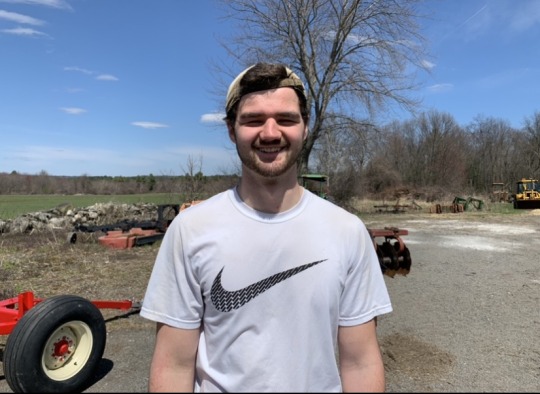
Paul “Mike” Laferriere on Ogonowski Farm
“I started working at Ogonowski Farm during the summer of 2015 when I was 15 years old,” Laferriere said. “I got my job from a good friend of mine, Douglas Hill, who invited me to come work with him and it went from there,” he explained. “I was just a hay hauler then but started working full time [during the summer months] around 2017.”
Ogonowski Farm is a 250+ acre farm in Dracut, Massachusetts that has been owned by the Ogonowski family for over 100 years. Current owner Jim Ogonowski produces hundreds of hay bales every year to be sold to horse farms throughout Massachusetts. Ogonowski Farm also grows chrysanthemums, pumpkins, apples, and cornstalks which are sold at a fall farm stand located in the front of Ogonowski Farm near the center of town.
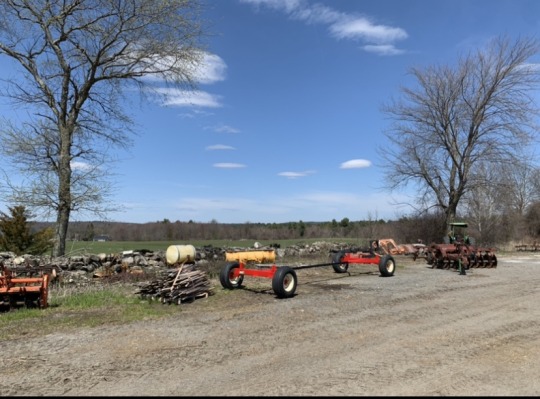
Scattered tools and equipment in the foreground, with a large hayfield in the background.
Jim Ogonowski often hires male students just entering high school or older to begin as hay haulers or to plant mums, which are tasks that require more help than his usual cast of five regular employees.
“I have moms messaging me on Facebook all the time asking if their son can work on the farm,” says Ogonowski. “I typically will try and give them a chance when we need some help planting mums or unloading [hay] wagons, but not everyone comes back.”
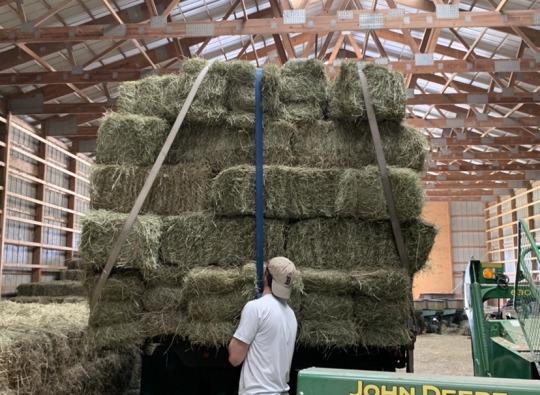
Laferriere straps down a stacked hay truck in preparation for a delivery to another farm.
The work that is completed on Ogonowski Farm can best be described as rigorous. Unloading wagons often occurs all day in the summer, where temperatures can be in the ‘80s. Hay is stacked in a barn on Ogonowski Farm meticulously to the ceiling, and the hay bales often weigh around fifty pounds. Furthermore, planting the “mums,” as Ogonowski calls them, is back-breaking work, as the simple action is repeated hundreds of times over the course of a day. But Laferriere has stuck around for five years now, developing his skills on the farm and becoming one of the farm’s most experienced employees. He works full time, typically 5-7 days a week during the summer, from mid-May to the end of August, and fills in when he can when he is home from school.
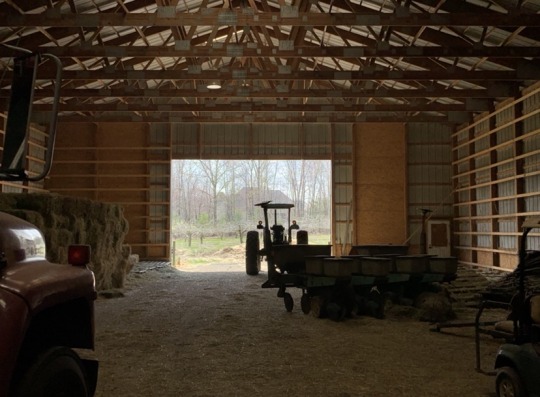
Laferriere tells me, “I had always seen myself working with my hands and such but I never expected to become a farmer, who would've thought that was something I could do?”
Even after growing up in a farming community such as Dracut, farming is not an occupation that many teenagers openly consider, or even have the opportunity to apply for. Yet Laferriere enjoys the work, and the nontraditional first job. He jokes that he always enjoys seeing people’s reactions when he first tells them that he works on a farm, and says that the most common question he is asked is: “What kind of animals do you have?”
Though strictly a hay and produce farm, along with a farm dog and a few stray cats, Ogonowski Farm has allowed for Laferriere to learn much about the business of farming and beyond. He explains that the number of skills he has learned as a result of his time on the farm has taught him more in a first job than he could ever expect, and he enjoys the hard work.
“I think the most interesting aspect of working on the farm is the problem solving aspect of our work there. The amount of problems I can solve because of my work on the farm is immense. But my favorite part is being able to work in the great outdoors. There's nothing like being in the fresh air and being a part of the natural world around you,” says Laferriere.
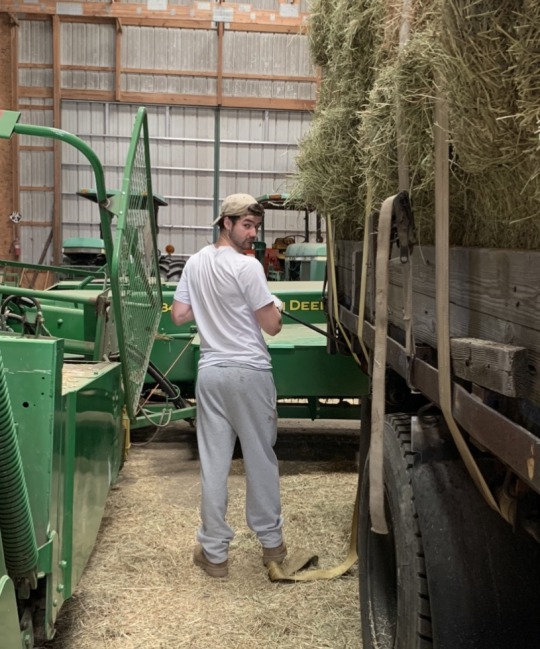
In my time on Ogonowski Farm, I have to admit, the natural beauty that is present on the farm is great. The massive fields, fruit and vegetables, and wildlife that you may see while at Ogonowski Farm present the “natural world” in a way that most high schoolers and college students do not get to experience when entering the workforce. Working on a farm allows for one to reconnect with nature in a way that is lost on most of today’s society, which Laferriere echoes in his exuberance when explaining his job to myself.
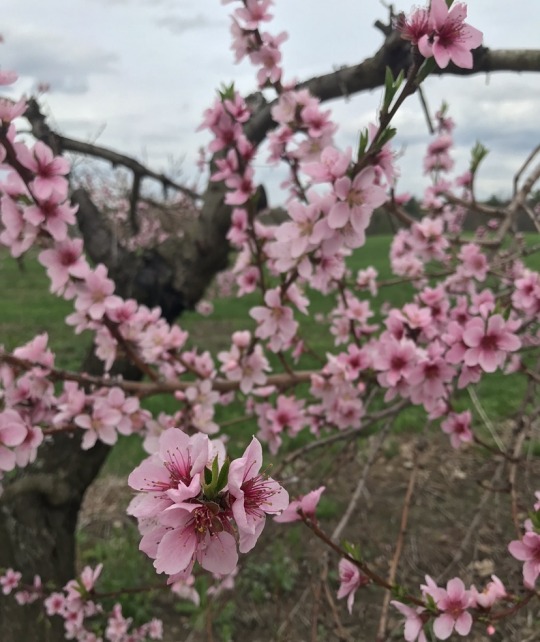
A peach tree flowers before it bears fruit. Peaches are a “not for sale” commodity at Ogonowski Farm.
Laferriere states, “I think it's important to understand the importance of the [farming] industry. I think it's too easy in today's technology-driven world to forget the work that goes into industries like farming and agriculture. I’d say working on a farm will definitely help you build character.”
Another aspect of working at Ogonowski Farm that Laferriere enjoys is the daily schedule, or lack thereof. Each day on the farm is different, as there are days when hours are spent preparing hay on tractors, delivering or stacking hay, completing landscaping around the farm, or completing construction projects and other odds and ends. Jim Ogonowski teaches his employees a number of skills, and the business of farming in general calls for an ability to be adaptable and prepared for anything during your day. In fact, I asked Laferriere to try and explain a typical day on the farm, and he laughed before answering.
“That's a hard question to answer as the actual work day can vary vastly from the intended plan for the day. If I were to guess I would say it consists of loading trucks with hay to be delivered to a customer, tending the fields on the tractor, and then delivering the hay we loaded on the trucks.”
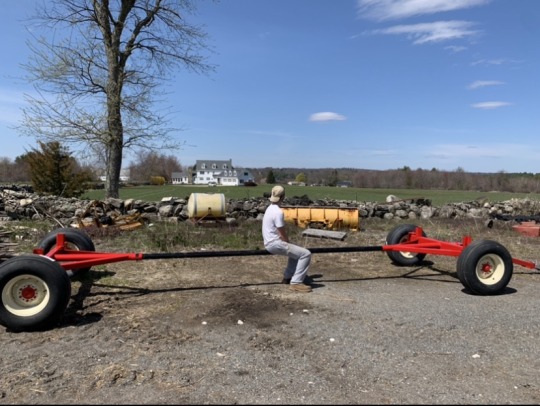
Laferriere sits on what will soon be the base of a mobile refrigerator for produce that he helped construct.
A farmer’s typical day, especially one in high school or college, does not come with typical work hours either. The employees of Ogonowski Farm usually only have a rough idea of how long their day may go, and they must be prepared to work long hours under the sun.
“It’s tough to know how long you’ll work each day you come in,” says Laferriere. “We have a busy time in the summer where we can be working eight-plus hour days for a while. Then we can work only around four hours or so for a while too. You also can’t typically do any work when it’s raining either, so Jim has to watch for that too.”
The unpredictable nature is only one of the things Laferriere must prepare for. As one of the farm’s senior employees he is partly responsible for monitoring the daily happenings of the farm, with the added responsibility of reporting back to boss Jim Ogonowski.
“Jim gives me a lot of responsibility, but I appreciate it,” says Laferriere. “He trusts me to do a good job, which means a lot.”
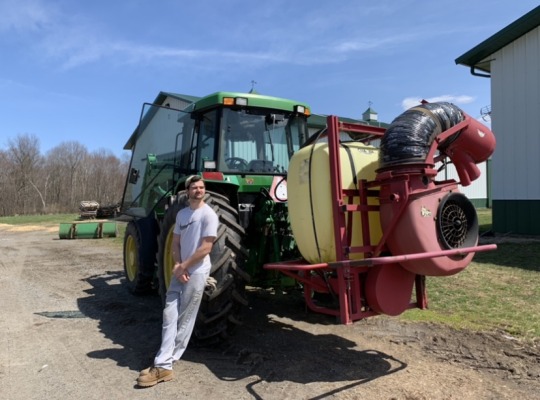
Laferriere stands in front of the farm’s largest tractor, which is used to spray chemicals and fertilizer throughout the fields.
Working on a farm is something that not everyone may dream of doing, but it has provided Laferriere with years of experience and abilities that he can carry with him beyond his time at Ogonowski Farm. As he completes his studies and moves into the field of Communication upon graduation, he will likely move away from a manual labor occupation like agriculture. However, the experience is something that he will hold close to him forever.
“I will look back on [my time on the farm] favorably. It will be something I will be proud to tell my children I did as a young man,” concludes Laferriere.
A first job indeed.
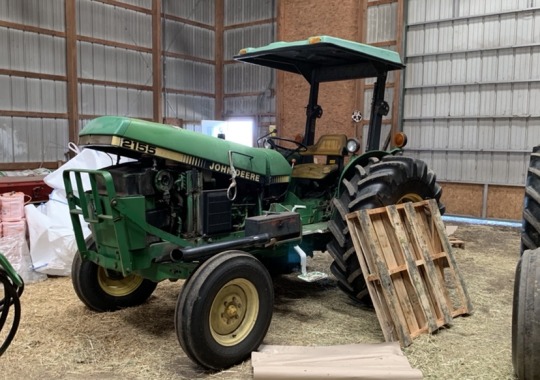
A 2155 Tractor, a common model on Ogonowski Farm, in storage until summer.
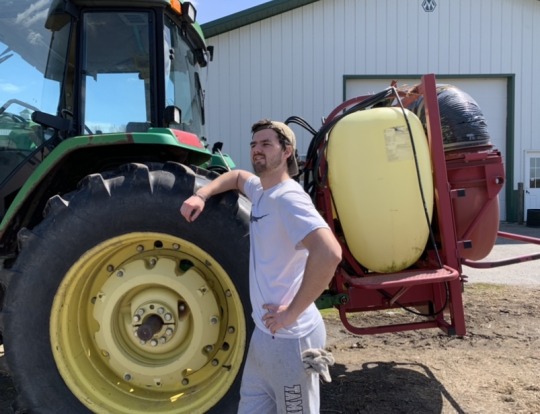
1 note
·
View note
